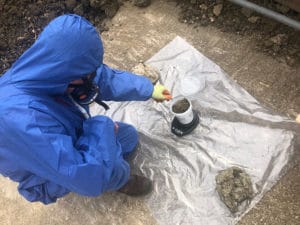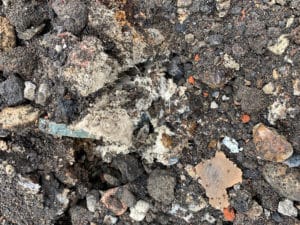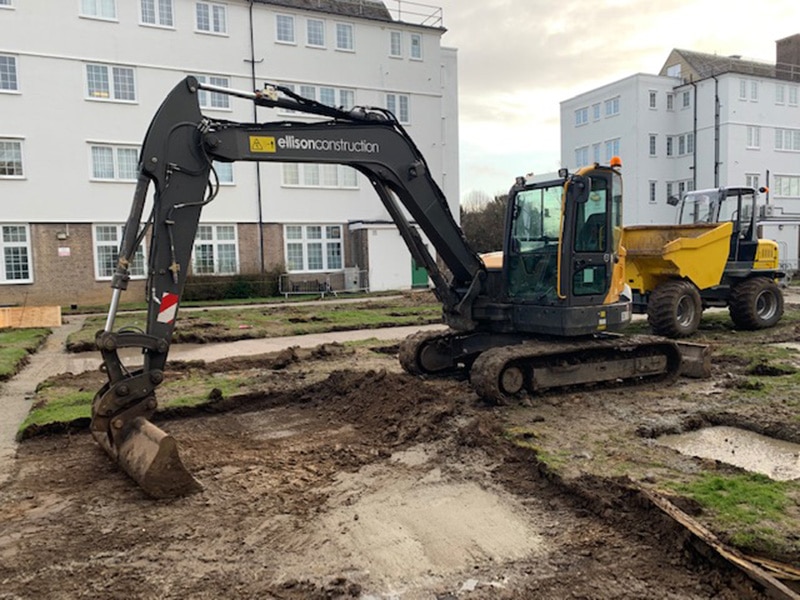An Introductory Guide to Asbestos Soil Sampling & Testing
Wherever asbestos may be located, be it in or on soil, soil sampling and testing/analysis must be undertaken. The results of this asbestos soil sampling will determine how to deal with potentially asbestos-contaminated land at your site. When this soil sampling and testing is carried out, it is important that it is undertaken to the correct standard. This means you’ll get the correct results to enable you to effectively plan and manage any asbestos risk in the most appropriate manner.
If it’s suspected that asbestos-containing materials or asbestos fibres are present in the soil, it’s usually due to historical demolition or construction activities at the site. As such, the asbestos in the soil can vary in condition and extent. Asbestos in soil can range from large, whole pieces to smaller fragmented pieces right through to microscopic asbestos fibre/fibre bundles that cannot be observed with the naked eye.
The extent of asbestos contamination found in soil can again vary dramatically. Some asbestos contamination can reach a very high percentage or, in some cases, a very low and negligible percentage. It is important that the asbestos soil sampling and testing provide you with the right information for your needs and ensure any asbestos risk can be managed effectively.
Asbestos Soil sampling and testing are sometimes undertaken as stand-alone services where asbestos is highly suspected or presumed to be present. Alternatively, soil sampling and testing can also be carried out as part of an asbestos-contaminated land survey.
How is an asbestos soil sample collected?
When the asbestos consultant visits site, they will first determine the ground conditions. Each area where a soil sample is to be collected, will be adequately treated. This is usually undertaken in 0.5m x 0.5m areas. Once an area has been established for soil sampling, any vegetation or similar, that will hinder the sampling process is removed.
A qualified asbestos consultant must undertake all asbestos soil sampling using the correct respiratory and personal protective equipment. It is imperative that soil samples are undertaken correctly to ensure the accuracy of the results.
Prior to sampling, the area will be treated with a fibre suppressant to control potential asbestos dust and fibre. The depth of the sampling will be determined by the sampling strategy as required by the customer’s needs. This should be agreed prior to carrying out the asbestos soil sampling. The soil sampling strategy will be different at each site, depending upon the customer’s plans and requirements.
Once the soil area is ready to be sampled, a thorough visual examination of the soil must be undertaken. The visual examination should include observations of stones and other media which may be present.
Additionally, suspected asbestos containing fragments should be noted along with any discrete soil layers which may need to be sampled separately. A record should be made of the presence of any visible fibres or fibre bundles within the soil.
Before taking the soil sample, a sample of all suspected asbestos-containing fragments must be taken from the soil separately. These samples of suspected asbestos fragments must be placed in individually annotated, suitably sealed containers. They should be fully recorded in detail and correspond to the area’s exact soil sample in question. These samples will need to be analysed along with the soil samples and results must show that they are bulk samples. These results will form part of the overall asbestos soil sampling and testing report related to the corresponding soil sample.
When taking the soil sample, all suspected large bulk asbestos fragments should be removed by handpicking. This means easily picked fragments that can be clearly identified as suspect asbestos-containing materials. These would have been recorded and sampled separately as above. The amount of soil to be collected for the sample should fill a one litre sealable clean plastic container.
This is approximately 2kg in weight of soil to be sampled. The soil should be collected using a small trowel or spade. After each sample collection, any tools and equipment must be cleaned before using for additional samples. All soil samples are then recorded appropriately and taken to the laboratory for analysis.
What information is recorded when an asbestos soil sample is collected?
It is important that during soil sampling, the correct information is recorded so that it forms part of a soil sampling report enabling you to have clear and concise information for planning purposes.
The following are the main items to be recorded during the soil sampling process:
- Ground and site conditions
- Photographs of the sample locations and generally of the site
- Visual identification details of suspected asbestos fragments and fibres/fibre bundles
- Grid reference or other agreed method for sample identification and location
- Plans showing locations of sample locations
How is analysis and testing of asbestos in soil samples undertaken?

Stage 1: Identification of asbestos according to HSG248
This stage tests the fragments, fibres, and fibre bundles that are clearly visible through a stereo microscope suspected to contain asbestos. Some larger fragments suspected of containing asbestos would have been removed at the sampling stage and analysed separately.
This analysis stage also uses higher magnification PLM for fine fibres and is carried out in accordance with current HSE guidance.
If, during the initial visual examination, to identify potential asbestos containing materials or fibre bundles, no asbestos is observed. More robust examinations will need to be completed on smaller subsamples taken from the main soil sample. These subsamples are then examined through stereo microscopy (x20 – x40 magnification). If this still does not identify asbestos-containing materials or fibre bundles, then this stereo microscopy is followed by PLM or PCM microscopy (x80 magnification).
This stage is used to identify the presence of bulk asbestos-containing materials, fibre bundles and fibres within the soil that has been sampled. Any identified asbestos is catagorised accordingly.
If, during this stage, the analysis reports “No Asbestos Detected,” i.e. identification of asbestos material, fibre or fibre bundles has been unsuccessful. It is not considered necessary to proceed with stages 2 and 3, which are for quantification purposes.
Although this testing procedure can be carried out on the soil sample in the condition it is delivered, a further element of the testing requires the sample to be kiln-dried so that the sample’s exact weight can be measured and recorded. This is making the sample ready for stage 2, the gravimetric analysis.
Stage 2: Gravimetric Analysis
The dried weight of the sample is confirmed. The whole sample is visually examined in detail. As with stage 1, all visually identified suspect asbestos materials and fibres within the soil sample are analysed and tested to confirm the presence of asbestos and its type.
Any fragments, fibres, and bundles of fibres are removed and grouped by type so that each group’s percentage can be measured and weighed. Once completed, the analyst can determine the percentage of bulk asbestos by weight within the soil sample.
Once this has been done to the main sample, the analyst then continues with smaller subsamples taken from the main soil sample and increases the analysis’s detail. This allows the analyst to calculate what is identified within the sub-sample back to the main sample to give an accurate percentage by weight ratio of each asbestos group identified.
Any large material removed from the whole sample must be weighed, as this data must be used to calculate the mass and weight ratio percentages.
If multiple fibres or fibre bundles are identified as asbestos, then the sample should undergo stage 3 of the soil testing to ascertain the percentage/concentration of respirable asbestos fibres present.
This is useful for potential asbestos waste disposal or future planning and activity, which may disturb the soil.
Stage 3: Free Dispersed Fibre Analysis
Following stage 2, the gravimetric method, a representative sub-sample undergoes liquid dispersion. The sample, once wet, undergoes vigorous agitation until the sample is adequately dispersed. The sample is then left to settle before the next stage of the test.
The next stage of the test is carried out using a filtration process that collects free fibres and fibre bundles. The fibres are collected on a cellulose filter, which is then placed on a microscope slide. During the microscopy, the fibres are then discriminated only to include asbestos fibre. The fibres are then counted and measured to give a fibre by weight percentage for the soil sample. These results can then be calculated to estimate the actual percentage of loose asbestos fibre and fibre bundles from the original soil sample mass.
To produce the result, each fibre counted during identification and measurement must be checked to ensure it conforms to a respirable fibre defined in HSG248, which is greater than 5um in length, narrower than 3um in width, and with an aspect ratio of greater than 3:1.
This stage is especially important if stages one and two have not identified bulk fragments of asbestos. If during the third stage, asbestos-free fibre has been identified, it means that the soil is indeed asbestos-contaminated but with non-visible respirable asbestos fibre.
What are the basics of the three stages for asbestos soil sample testing?

- Stage 1: Identify if asbestos is present or not
- Stage 2: The percentage by weight ratio of asbestos bulk material
- Stage 3: The percentage by weight ratio of asbestos-free fibre
As above should stage one be carried out, and the soil sample is considered to be “no asbestos detected.” There is no need for carrying out stage 2 and 3, as there is no asbestos identified for giving a percentage of asbestos by weight ratio for the soil sample.
What will the asbestos sampling report contain?
The report of asbestos in soil sampling and testing will contain all of the following information:
- Ground and site conditions
- Photographs of the sample locations and generally of the site
- Visual identification details of suspected asbestos fragments and fibres/fibre bundles
- Grid reference or other agreed method for sample identification and location
- Plans showing locations of sample locations
- Sample results for larger bulk fragments
- Sample results for all three stages of the soil analysis
- Recommendations for appropriate action
How long does asbestos in soil sampling and testing take?
The timescales for both the sampling of soils and the testing are hugely dependent upon the number of soil samples required.
Generally, soil sampling can be undertaken within 24hrs with results being released after a period of two to three additional days. If the site is particularly large and many soil samples are required, including from excavation pits, some soil sampling strategies can take as long as two to three weeks. Testing of this number of soil samples can also take more than a week to process. If you need confirmed timescales on soil sampling and testing, contact a member of the Oracle team for more information.
Do you need to be accredited for asbestos in soil testing?
Yes. Testing laboratories in the UK must be accredited to ISO/ESO 17025 by UKAS in order to provide an asbestos testing Service. UKAS “The United Kingdom Accreditation Service” is the only provider of the required accreditation to effectively provide analysis for asbestos, which includes asbestos in soil. All soil testing undertaken by Oracle is carried out by fully UKAS accredited laboratories.
How can Oracle help with my asbestos soil sampling and testing?
Oracle can provide every service you will ever need if you have or suspect you have asbestos-contaminated soil:
- Asbestos in Soil Testing
- Asbestos Contaminated Land Surveys
- Asbestos Bulk Testing
- WAC Testing
- Asbestos Air monitoring
- Asbestos Surface Contamination Removal – Asbestos Litter Picking
- Asbestos Contaminated Soil Removal & Excavation
- Asbestos Contaminated Soil & Waste Transportation
- Asbestos Contaminated Soil & Waste Disposal
- Full Asbestos Management Service – Risk Assessment & Planning
Oracle Solutions Are:
- HSE Licensed – For asbestos removal and remediation
- UKAS Accredited – For asbestos surveying and testing
- Environment Agency Licensed – For asbestos transportation
- Environment Agency Licensed – For asbestos disposal

